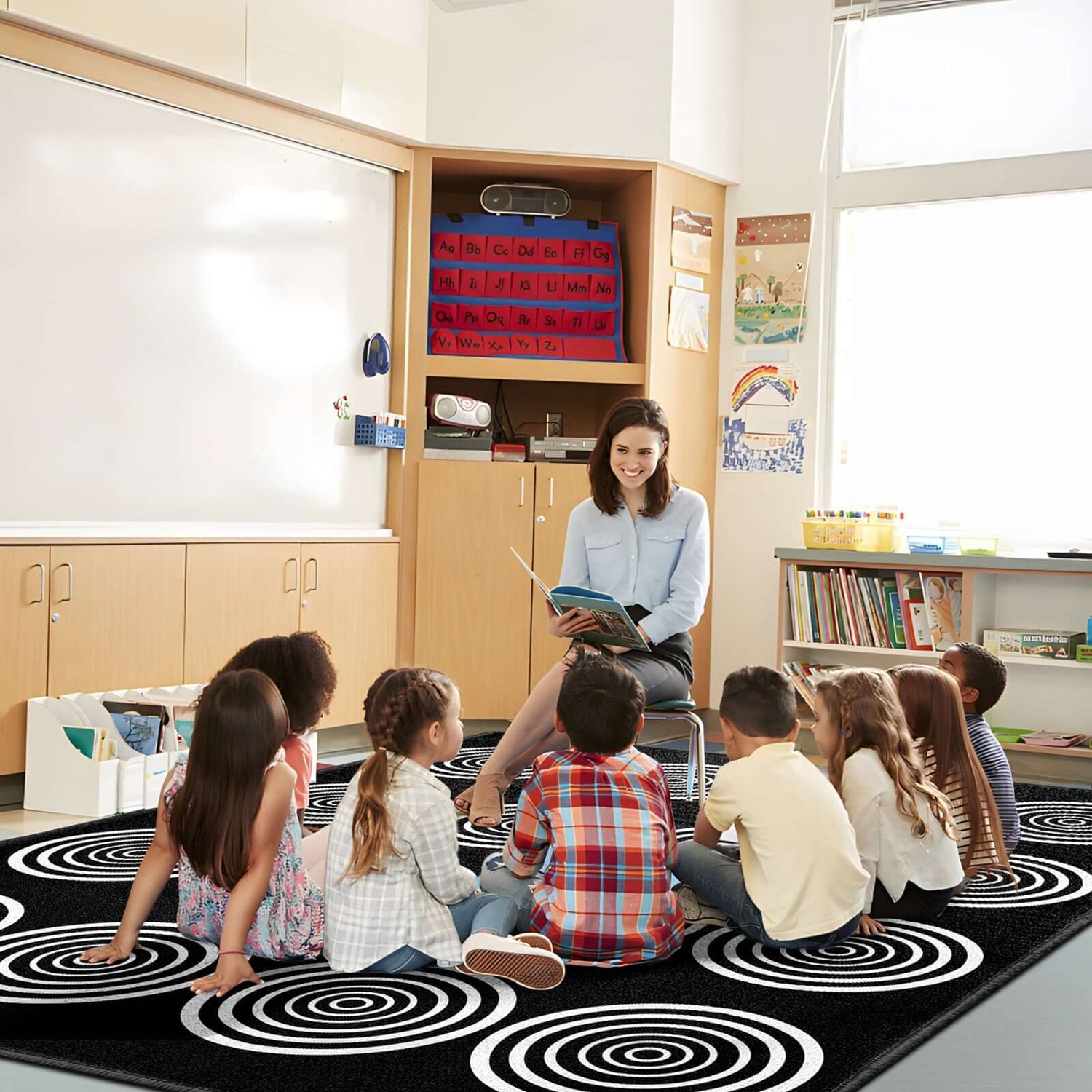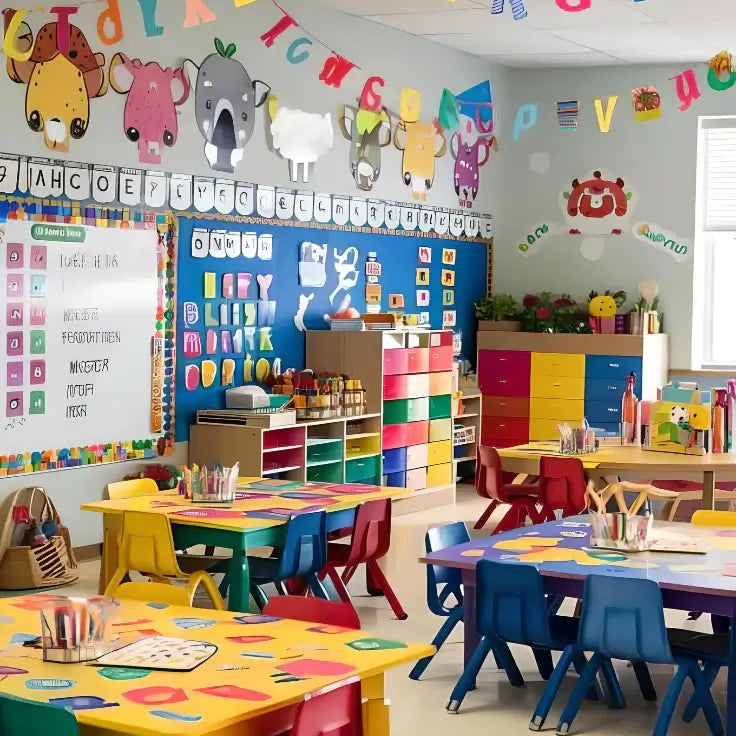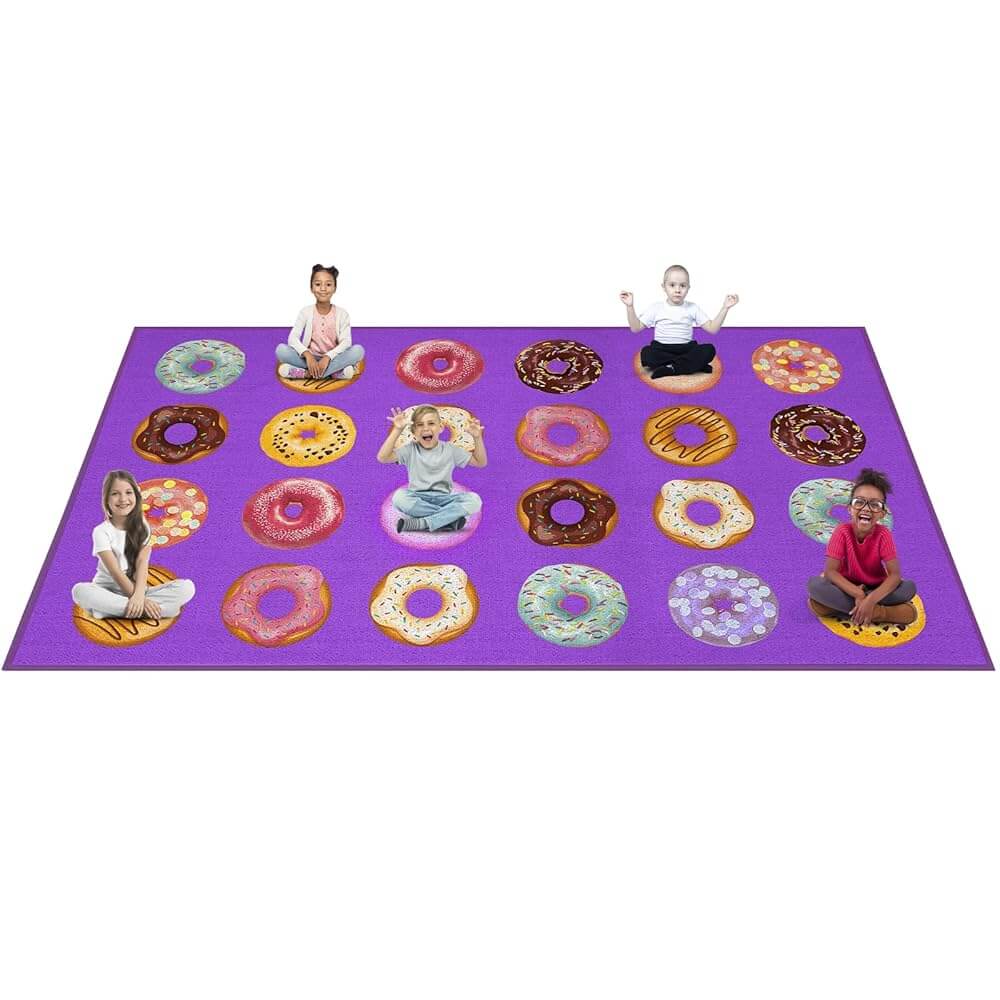Why Classroom Rugs Matter for Student Success
Educational research consistently shows that comfortable, well-designed learning environments directly impact student engagement and academic performance.
According to studies from the Harvard Graduate School of Education, physical classroom environments can influence learning outcomes by up to 25%.
Classroom rugs play a crucial role in creating these optimal learning conditions.
A quality classroom rug provides several key benefits:
Comfort and Focus: Soft surfaces allow students to sit comfortably during floor activities, reducing distractions and helping maintain attention during lessons.
When students aren't fidgeting due to hard floors, they can better focus on learning objectives.
Defined Learning Spaces: Rugs naturally create boundaries within classrooms, helping teachers organize different activity zones.
This spatial organization supports classroom management and helps students understand expectations for different areas.
Acoustic Benefits: Carpeted surfaces absorb sound, reducing noise levels that can interfere with learning.
This is particularly beneficial in busy classrooms where multiple activities occur simultaneously.
Safety Enhancement: Quality rugs provide cushioning that reduces injury risk during floor activities and creates non-slip surfaces when properly maintained.
Essential Features to Look for in Educational Rugs
When selecting classroom rugs, several critical factors determine their effectiveness and longevity in educational settings.
Durability and Construction: Classroom rugs endure heavy daily use from numerous students. Look for rugs with reinforced edges, high-density pile construction, and commercial-grade materials.
Nylon and polypropylene fibers offer excellent durability while maintaining appearance over time.
Safety Certifications: Educational rugs should meet strict safety standards, including flame resistance ratings and low-emission materials.
Look for CRI Green Label Plus certification, which ensures low chemical emissions suitable for school environments.
Easy Maintenance: Stain-resistant treatments and materials that withstand frequent cleaning are essential.
Rugs should handle spills, marker accidents, and regular vacuuming without deteriorating.
Size Considerations: Measure your intended space carefully, allowing adequate room for student seating while maintaining clear pathways.
Standard classroom rugs range from 6x9 feet for small group areas to large classroom rugs like 12x15 feet for whole-class gatherings.
Educational Design Options That Enhance Learning
Modern classroom rugs incorporate educational elements that support curriculum objectives across subjects.
Alphabet and Phonics Rugs: These designs help early learners with letter recognition, phonetic awareness, and vocabulary development.
Interactive elements like removable letters or textured surfaces add tactile learning opportunities.
Mathematical Learning Rugs: Number grids, geometric shapes, and measurement guides integrated into rug designs provide constant visual references for mathematical concepts.
These tools support kinesthetic learners who benefit from physical interaction with mathematical ideas.
World Maps and Geography Rugs: Geographic designs foster global awareness and support social studies curriculum.
Students can physically walk through continents, trace trade routes, or locate countries during lessons.
Reading and Storytelling Designs: Library-themed rugs or designs that encourage storytelling create inviting spaces for literacy activities.
These rugs signal to students that the area is designated for quiet, focused reading time.
Age-Appropriate Selections for Different Grade Levels
Different age groups have varying needs and preferences when it comes to classroom rug designs and functionality.
Early Elementary (K-2): Colorful designs simple patterns, and interactive elements work best for younger students.
Rugs with clear seating spots help with classroom management, while educational themes support foundational skill development.
Upper Elementary (3-5): More sophisticated designs that avoid appearing childish while still providing educational value work well.
Neutral colors with subtle educational elements allow the rug to complement rather than dominate classroom décor.
Middle School: Solid colors or simple geometric patterns typically work best, as overly themed designs may seem juvenile.
Focus on comfort and durability rather than educational graphics for this age group.
Creating Effective Learning Zones with Strategic Rug Placement
Strategic rug placement maximizes educational impact while supporting classroom flow and management.
Reading Corners: Position reading rugs away from high-traffic areas to create quiet spaces for independent reading.
Ensure adequate lighting and consider pairing with comfortable seating options like bean bags or floor cushions.
Circle Time Areas: Large circle time rugs work best for group discussions and lessons.
Ensure all students can sit comfortably while maintaining clear sight lines to instructional materials.
Learning Centers: Smaller rugs can define specific activity areas like math manipulative centers, science exploration stations, or art project spaces.
This helps students understand expectations for different areas.
Flexible Arrangements: Consider modular rug systems that allow for easy reconfiguration as classroom needs change throughout the year.
Maintenance and Longevity Tips
Proper care extends rug life and maintains healthy classroom environments.
Daily Maintenance: Regular vacuuming removes surface dirt and prevents embedded debris. Pay special attention to high-traffic areas and edges where dirt accumulates.
Spot Cleaning: Address spills immediately using appropriate cleaning solutions. Keep cleaning supplies readily available and train students in basic spill response procedures.
Professional Cleaning: Schedule professional deep cleaning during school breaks to remove embedded dirt and refresh rug appearance. This also helps maintain indoor air quality standards.
Rotation Strategy: If budget allows, having backup rugs enables rotation that extends overall rug life while ensuring continuous classroom functionality.
Budget-Friendly Options and Investment Strategies
Quality classroom rugs represent significant investments, but strategic approaches can maximize value.
Grant Opportunities: Many educational grants include funding for classroom environment improvements.
Research local and national grant opportunities that support learning environment enhancements.
Bulk Purchasing: Coordinating purchases with other teachers or grade levels often results in bulk pricing discounts from educational suppliers.
Seasonal Sales: Educational suppliers typically offer significant discounts during back-to-school seasons and end-of-fiscal-year periods.
Quality Investment: While premium rugs cost more initially, their extended lifespan often provides better long-term value than frequent replacement of cheaper alternatives.
Health and Safety Considerations
Classroom rugs must meet stringent health and safety requirements to protect student wellbeing.
Air Quality: Choose rugs with low or no volatile organic compound (VOC) emissions. Poor indoor air quality can affect student health and learning capacity, making this a crucial consideration.
Allergen Management: Hypoallergenic materials and proper maintenance routines help accommodate students with allergies or respiratory sensitivities.
Slip Resistance: Ensure rugs have appropriate backing materials that prevent sliding, especially important in high-activity areas.
Chemical Safety: Avoid rugs treated with harmful chemicals. Look for products certified by recognized safety organizations and environmental standards.
Technology Integration and Modern Classroom Needs
Contemporary classrooms increasingly integrate technology, requiring rugs that accommodate modern teaching methods.
Device Compatibility: Consider rugs that won't interfere with tablet or laptop use during floor activities. Smooth, stable surfaces support technology integration during collaborative learning.
Charging Station Access: Plan rug placement to maintain access to electrical outlets for device charging stations and other classroom technology needs.
Interactive Elements: Some modern educational rugs incorporate QR codes or augmented reality features that connect to digital learning resources, bridging physical and digital learning experiences.
Conclusion: Investing in Student Success Through Quality Learning Environments
Classroom rugs represent more than decorative elements—they're educational tools that support student comfort, learning engagement, and classroom management.
By carefully considering factors like durability, educational value, safety standards, and maintenance requirements, teachers can select rugs that enhance learning environments for years to come.
The investment in quality classroom rugs pays dividends through improved student engagement, better classroom organization, and enhanced learning outcomes.
When students feel comfortable and inspired by their physical learning environment, they're better positioned to achieve academic success.




Leave a comment
This site is protected by hCaptcha and the hCaptcha Privacy Policy and Terms of Service apply.